BIOGRAPHY - Page 3
This page deals with Kang's uninterupted timeline, in which he first becomes RAMA-TUT and then later the SCARLET CENTURION.
As a teenager, Nathaniel Richards was a genius and a dreamer, making him a target for bullies. One day, Nathaniel was tinkering with his stimuloid (a prototype for Kang's future Growing Man construct), when a group of school toughs roughed him up. Nathaniel's throat was slit by the sharpened edge of Morgan's hover board, leaving him laid up in the hospital for weeks. This incident permanently tarnished Nathaniel's view of his fellow man, coloring his perceptions and interests from then onwards. [Young Avengers (1st series) #2]
The idyllic nature of the 30th century weighed on Nathaniel's mind as he grew older. Unchallenged peace and prosperity wasn't stimulating for the adventurer at heart within Nathaniel. 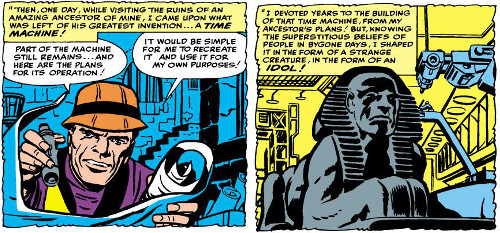 He only found respite in the holo-tapes archiving the heroic era of the 20th century. (Due to the divergence between Earth-616 and Other-Earth, these tapes had to have been brought sideways from Earth-616, by Nathaniel Richards the Benefactor or others.) Upon reaching adulthood, Nathaniel grew desperate for stimulation and journeyed to the preserved citadel of his venerated ancestor, hoping to find something of interest in the archived records. In fact, he discovered the remains of a time machine belonging to his ancestor, archived away and forgotten. With the parts of the time machine he found, combined with sets of blueprints, Nathaniel was able to re-engineer a working time machine from the equipment. [Fantastic Four (1st series) #19]
He only found respite in the holo-tapes archiving the heroic era of the 20th century. (Due to the divergence between Earth-616 and Other-Earth, these tapes had to have been brought sideways from Earth-616, by Nathaniel Richards the Benefactor or others.) Upon reaching adulthood, Nathaniel grew desperate for stimulation and journeyed to the preserved citadel of his venerated ancestor, hoping to find something of interest in the archived records. In fact, he discovered the remains of a time machine belonging to his ancestor, archived away and forgotten. With the parts of the time machine he found, combined with sets of blueprints, Nathaniel was able to re-engineer a working time machine from the equipment. [Fantastic Four (1st series) #19]
As he prepared to journey through time, however, he was suddenly confronted by a divergent version of the Fantastic Four. Mandroid, Dragonfly, Ultra-Woman and the Big Brain had been sent through time by Uatu the Watcher and the Time Variance Authority to preemptively stop a plan by Immortus in the far future of his personal timeline to seize an enormous amount of nexus energy and become a sentient "Immortus Wave." The TVA believed an injection known as the Saturnyne 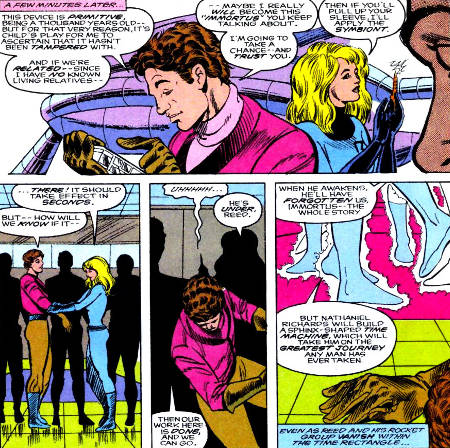 Symbiont would make Nathaniel resistant to housing nexus energy, and thereby retroactively prevent Immortus from claiming the power of time itself.
Symbiont would make Nathaniel resistant to housing nexus energy, and thereby retroactively prevent Immortus from claiming the power of time itself.
Unfortunately for the Fantastic Four, the suspicious Nathaniel didn't believe their story and turned his ancestors' war machines against the new arrivals. In short order, the Four were murdered by the future technology at Nathaniel's disposal. A second "Four" then emerged from time -- Reed Richards and his Rocket Group, from a reality where the Fantastic Four never took that fateful flight through the cosmic ray storm. This Foursome's approach was better accepted by Nathaniel. He used their genetic scanner to confirm the relationship between him and Reed, and acquiesced to the Symbiont. With this act, Nathaniel prevented his own future godhood, and awoke from the sedative moments later with no recollection of these events. [What If..? (2nd series) #39]
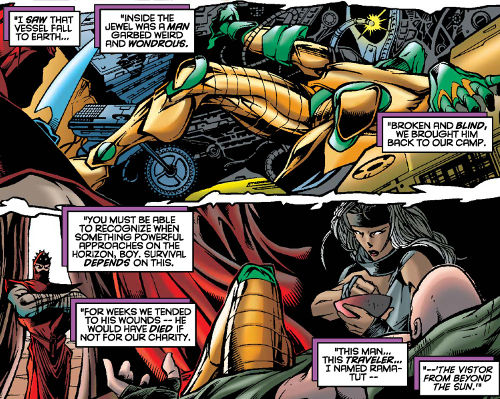 Nathaniel decided to travel to the era of ancient Egypt, and constructed a great idol around his time-sphere in order to play on the superstitions of the local people. And so, the legend of the Sphinx was born. Nathaniel's voyage brought him back to 2950 B.C. A time-storm caused the Sphinx to crash-materialize in the ancient past, however, damaging the time travel mechanisms. [Fantastic Four (1st series) #19]
Nathaniel decided to travel to the era of ancient Egypt, and constructed a great idol around his time-sphere in order to play on the superstitions of the local people. And so, the legend of the Sphinx was born. Nathaniel's voyage brought him back to 2950 B.C. A time-storm caused the Sphinx to crash-materialize in the ancient past, however, damaging the time travel mechanisms. [Fantastic Four (1st series) #19]
Worse, Nathaniel was thrown free of his Sphinx as it landed, crashing in a small pod from the ship out in the shifting desert sands. He only survived thanks to the benevolence of Baal and the People of the Sands. Blind and injured from the impact, Nathaniel was brought back to their camp for nursing and care. It was Baal who named him Rama-Tut, meaning "Visitor from Beyond the Sun". When he was well enough, Rama fled the People of the Sands and made his way to the City of Kings. Although still blind, his ultra-diode ray and displays of 31st century power cowed the populace into serving him. Using local herbs that had been irradiated by his arrival, Rama recreated an optic nerve restorative known to the medicine of his time. With his sight returned and his seat of power reclaimed at the Sphinx, Rama-Tut conquered the Egyptians with ease. The superstitious and the fearful believed him to be a living god, casting aside the old royal family and giving him the throne.
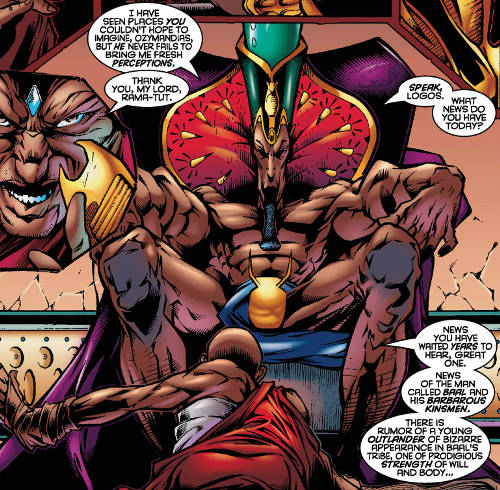 Renewed and emboldened by the armies at his command, Rama-Tut returned to the People of the Sands to reclaim the rest of his time-ship. In particular, he sought an element from his ship the Sandstormers would come to know as The Eye of the Ages, a chrono-projector capable of displaying and forecasting the recorded future of his time. Baal had found the Eye first, however, and saw in it the coming tyranny of Rama-Tut, as well as a foretold Eternal One that might stop his reign. When the People of the Sands refused to turn over the time-ship, Rama-Tut's armies massacred them, forcing Baal and the surviving Sandstormers to forever remain hunted nomads and highwaymen on the outskirts of the kingdom.
Renewed and emboldened by the armies at his command, Rama-Tut returned to the People of the Sands to reclaim the rest of his time-ship. In particular, he sought an element from his ship the Sandstormers would come to know as The Eye of the Ages, a chrono-projector capable of displaying and forecasting the recorded future of his time. Baal had found the Eye first, however, and saw in it the coming tyranny of Rama-Tut, as well as a foretold Eternal One that might stop his reign. When the People of the Sands refused to turn over the time-ship, Rama-Tut's armies massacred them, forcing Baal and the surviving Sandstormers to forever remain hunted nomads and highwaymen on the outskirts of the kingdom.
Rama-Tut's concern was not only for the Eye itself, but also the knowledge it held about the Eternal One. Rama knew this Eternal One would become Apocalypse, self-proclaimed defender of the mutant race and Celestial guardian of evolution. Apocalypse would either be an insurmountable threat to his new kingdom, or the perfect heir to the dynasty of Rama-Tut. Rama knew En Sabah Nur was prophesized to be born somewhere in this era and area, but without the Eye he could not pinpoint the exact time and place. Over the years that followed, Rama-Tut's riders searched the sands for signs of En Sabah Nur, while he also built his dynasty. From the old royal line, he made king-to-be Ozymandias into his warlord, keeping him under a watchful eye. Rama also planned to wed the princess Nephri, in order to consolidate his rule among the traditionalist population. His Vizier was a learned man named Logos, the premiere scientist and forward-thinker of his era, always imagining new engineering marvels such as the pyramids and ziggurats of the City of Kings, and tracking the phases of the sun and the moon. [Rise of Apocalypse #1-2]
The reign of Rama-Tut is forgotten in the annals of time, and so reports of his rule vary in length. Some say he was lord of the seven suns for ten years, other say closer to twenty. During his reign, Rama-Tut had few rivals, as he successfully kept the ambitious Ozymandias in line. He was opposed by the Nile sorceress Samira for a time, but manipulated the time-traveling Killpower and Codename: Genetix into diverting her attentions away from his throne. [Killpower: The Early Years #1-2]
Still, by the end of his rule, Rama-Tut had become arrogant in his self-proclaimed godhood, crushing one revolt after another by the slave caste. His long search for En Sabah Nur seemed to be at an end as well, for Logos brought word of the Sandstormers' base camp. Arrogant Ozymandias underestimated the People of the Sands, however, and led his troopers into an ambush. Ozymandias was the only known survivor of the clash that ended with the sands giving way to caves underneath, burying all involved. He returned a self-proclaimed conqueror, convinced Nur must have died in the collapse as well.
He did not. The now seventeen year old En Sabah Nur saw his adopted father Baal die as a result of the cave-in, and swore vengeance. He spent weeks clawing his way to the surface, his mutant physiology surviving on scarce scarab beetles he ate to survive. He was found by Logos, who offered Nur the chance for revenge against Rama and Ozymandias by secreting him among the slave caste building the pyramids until he fully recuperated. [Rise of Apocalypse #1-2]
Rama-Tut's rule faced more than one challenger, for the gods of old were not amused by his reign. Khonshu, God of the Moon and Taker of Vengeance, was displeased that his temples had fallen into ruin at the command of the pharaoh. More than one revolt occurred at the encouragement of Khonshu and his loyal priests. When the West Coast Avengers arrived in ancient Egypt in a malfunctioning time machine, they too fell before Rama-Tut and his ultra-diode 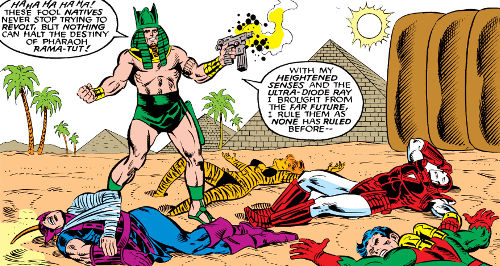 ray, but not before Khonshu cloaked their true nature from Rama's senses so he did not recognize these heroes from the future. Their paralyzed bodies were dumped like refuse at the temple of Khonshu by Rama's guards, allowing the God of the Moon to add them to his plans. [West Coast Avengers (2nd series) #20-21]
ray, but not before Khonshu cloaked their true nature from Rama's senses so he did not recognize these heroes from the future. Their paralyzed bodies were dumped like refuse at the temple of Khonshu by Rama's guards, allowing the God of the Moon to add them to his plans. [West Coast Avengers (2nd series) #20-21]
En Sabah Nur made his move against Rama-Tut with the help of Logos and Nephri, trying to enter the Sphinx to acquire more of pharaoh's great science. He was uncovered, however, and his allies were brought before the people of Egypt on stakes to be executed as traitors and conspirators. Rumors had already spread through the people of En Sabah Nur's great power, and so Rama-Tut tried to bend Nur to his will. He offered to spare Nephri for Nur, providing he bowed before Rama-Tut as his chosen heir. Nur refused to bow, and so Rama-Tut took a secondary victory by blasting Nur with his ultra-diode ray, showing the people that even the "chosen of the gods" would fall before the might of the pharaoh. [Rise of Apocalypse #3]
Matters were complicated further by the arrival of the Fantastic Four from their early days, who had uncovered hieroglyphics in the future of Rama's reign and had came seeking his optic nerve 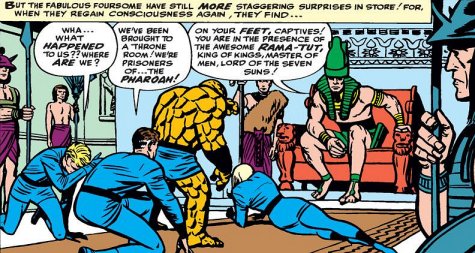 restorative for Alicia Masters. Rama-Tut delighted in using his ultra-diode ray to dominate the will of the greatest heroes of the Heroic Age and, with Nephri spurned as a conspirator, plotted to make Sue Storm his new bride. The other will-sapped members of the Four were put to work elsewhere in his kingdom. [Fantastic Four (1st series) #19] Little did Rama-Tut realize he had set the stage for his own fall as Khonshu, the West Coast Avengers, En Sabah Nur, the Fantastic Four and even yet-another time-traveler, Doctor Strange, circled around him.
restorative for Alicia Masters. Rama-Tut delighted in using his ultra-diode ray to dominate the will of the greatest heroes of the Heroic Age and, with Nephri spurned as a conspirator, plotted to make Sue Storm his new bride. The other will-sapped members of the Four were put to work elsewhere in his kingdom. [Fantastic Four (1st series) #19] Little did Rama-Tut realize he had set the stage for his own fall as Khonshu, the West Coast Avengers, En Sabah Nur, the Fantastic Four and even yet-another time-traveler, Doctor Strange, circled around him.
The West Coast Avengers led another uprising against Rama-Tut with the support of Khonshu and new weaponry built for the freedom fighters by Hawkeye. Their siege of the palace diverted some of Rama-Tut's robot servitors long enough for Doctor Strange to awaken from injuries he had suffered and release his astral form before his body was entombed in a stasis field, [West Coast Avengers (2nd series) #22] letting him fly free and find the mighty Thing rowing in one of Rama's galleons under the influence of the ultra-diode ray. Strange used the power of the sun to trigger the Thing's transformation back into Ben Grimm, who was unaffected by the ultra-diode ray. Under Strange's guidance, [Doctor Strange (2nd series) #53] Ben made his way back to the palace and stole the ultra-diode ray long enough to restore Sue's will before he reverted back to the will-sapped Thing. Sue then freed the rest of the Fantastic Four, who put Rama-Tut on his heels. Rama-Tut was forced to flee from the reunited Fantastic Four, and entered the hidden chambers in his Sphinx-ship. Having long ago fixed the damaged time travel mechanisms, Rama-Tut reluctantly abandoned his kingdom. He launched his time-ship pod from inside the Sphinx's shell, and re-entered the timestream. [Fantastic Four (1st series) #19] As Rama-Tut fled, En Sabah Nur destroyed what remained of his Sphinx's technology, leaving him without a base to return to. [Rise of Apocalypse #4]
On his way through the timestream, Rama-Tut's ship was caught in some temporal turbulence and ejected into space during the Heroic Age. On his first crash, the control module of his time-ship was damaged. He sought the "assistance" of intuitive mechanic and time-traveler, Blaquesmith, taking the small genius prisoner. Blaquesmith's capture prompted the arrival of Cable, intent on rescuing his mentor. Rama's unstable machine was reactivated during the skirmish, sending him back into the timestream. [Cable (1st series) #57]
By happenstance, his next materialization in the Heroic Age had him cross paths with Doctor Doom years earlier, who had fallen into the vacuum of space after an encounter with the Fantastic 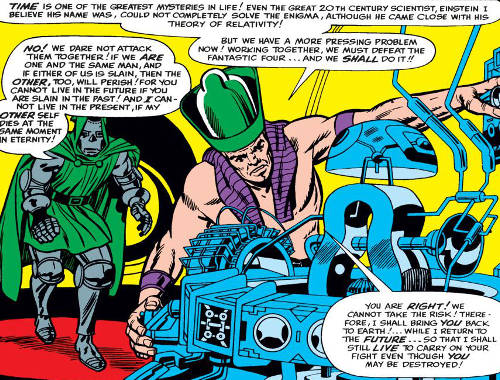 Four. Rama-Tut brought the Latverian dictator aboard his ship and revived him from his near-death state. Thrilled at meeting one of the most brilliant conquerors of history, Rama-Tut related his origins to von Doom and the discovery of his ancestor's time machine. He speculated that the time machine may have been Doom's creation, making them related. Rama-Tut even went so far as to suggest he and Doom were the same man at different points in their lifetime. This odd claim seems to have had no basis in fact, and Kang later admitted to deliberately misleading the weakened Doom in the hopes of using him as an ally in later schemes. Rama-Tut dispatched Doctor Doom back to Earth before proceeding with his own plans. [Fantastic Four Annual (1st series) #2, Avengers Forever #9]
Four. Rama-Tut brought the Latverian dictator aboard his ship and revived him from his near-death state. Thrilled at meeting one of the most brilliant conquerors of history, Rama-Tut related his origins to von Doom and the discovery of his ancestor's time machine. He speculated that the time machine may have been Doom's creation, making them related. Rama-Tut even went so far as to suggest he and Doom were the same man at different points in their lifetime. This odd claim seems to have had no basis in fact, and Kang later admitted to deliberately misleading the weakened Doom in the hopes of using him as an ally in later schemes. Rama-Tut dispatched Doctor Doom back to Earth before proceeding with his own plans. [Fantastic Four Annual (1st series) #2, Avengers Forever #9]
Remaining in the Heroic Age, Nathaniel decided to craft a new identity as the Scarlet Centurion, and manipulate the heroes of the time for his own ends. Through a combination of his own time travel technology and super-advanced hypnotic aids, the Scarlet Centurion devised a costume that allowed him to subtly influence the behavior of others. At a point shortly after the Black Panther joined the Avengers, the Centurion subliminally manipulated Captain America into doubting the death of his partner Bucky Barnes from decades earlier, and Cap led the Avengers into using Doc Doom's time machine to observe the event as wraith-like intangible watchers. The Wasp was left behind to manipulate the controls, but Scarlet Centurion pushed her into falling asleep and altered the equipment so that Cap and the Avengers fully materialized in 1945 and briefly fought Baron Zemo at the site of Bucky's death. [Avengers (1st series) #56]
This caused a temporal divergence and a new timeline separate from Earth-616 that the Scarlet Centurion could guide to his advantage. In this new timeline, the Centurion appeared before the 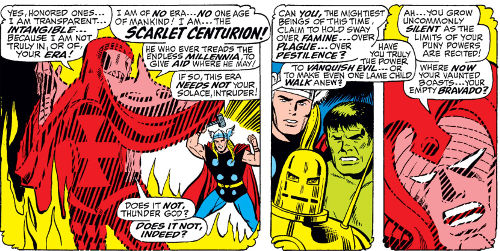 original Avengers shortly after their battle with the Space Phantom, when the Hulk was planning to leave the team. The Scarlet Centurion stopped Hulk from leaving and used his subliminal effects to influence the Avengers into doing his bidding. He convinced the Avengers that he was a benevolent force from the future who could create a utopia on Earth with their help. The only thing standing between Earth and his gifts was the proliferation of superhumans in the era. Under the Centurion's corruptive guidance, the original Avengers defeated the Fantastic Four, X-Men, Spider-Man, Daredevil and other heroes and villains of the era, banishing them to Limbo.
original Avengers shortly after their battle with the Space Phantom, when the Hulk was planning to leave the team. The Scarlet Centurion stopped Hulk from leaving and used his subliminal effects to influence the Avengers into doing his bidding. He convinced the Avengers that he was a benevolent force from the future who could create a utopia on Earth with their help. The only thing standing between Earth and his gifts was the proliferation of superhumans in the era. Under the Centurion's corruptive guidance, the original Avengers defeated the Fantastic Four, X-Men, Spider-Man, Daredevil and other heroes and villains of the era, banishing them to Limbo.
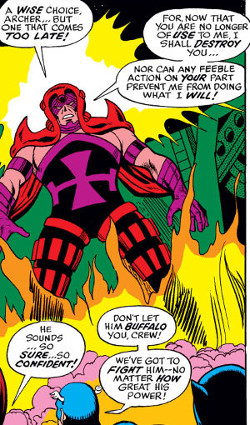 Next, the Centurion arranged for the Earth-616 Avengers returning from the past to arrive in this present instead of their own. By turning the two groups of Avengers against each other, the Centurion expected the more seasoned Avengers from the original timeline to outfight their counterparts, leaving the new Earth free for him to dominate. He believed he could then beat these Avengers himself since, despite their additional experience, they lacked the raw power of Hulk, Thor and Iron Man. Well, the Scarlet Centurion was only half-right -- after the Avengers-616 defeated Centurion's Avengers, Hank Pym then bested him as Ant-Man by shrinking down inside Doctor Doom's time machine and causing feedback which unhinged the Centurion from that timeline.
Next, the Centurion arranged for the Earth-616 Avengers returning from the past to arrive in this present instead of their own. By turning the two groups of Avengers against each other, the Centurion expected the more seasoned Avengers from the original timeline to outfight their counterparts, leaving the new Earth free for him to dominate. He believed he could then beat these Avengers himself since, despite their additional experience, they lacked the raw power of Hulk, Thor and Iron Man. Well, the Scarlet Centurion was only half-right -- after the Avengers-616 defeated Centurion's Avengers, Hank Pym then bested him as Ant-Man by shrinking down inside Doctor Doom's time machine and causing feedback which unhinged the Centurion from that timeline.
Nathaniel Richards was forced out of that universe, unable to conqueror it as he had intended. It did, however, awaken in him a desire to test his mettle by one day conquering this Age of Heroes. [Avengers Annual (1st series) #2]
Click here to follow Nathaniel Richards in his continuing adventures as the Scarlet Centurion.
Click here to follow Nathaniel Richards to the 41st century, where he becomes Kang the Conqueror.
